Aromatic bitters are primarily used to enhance the flavor of cocktails, adding depth and complexity with just a few dashes. They're essential in classic drinks like the Old Fashioned and Manhattan, where they complement other flavors beautifully. Beyond cocktails, you can use bitters in non-alcoholic drinks, like sparkling water, or enhance dishes such as salad dressings and desserts. Their versatility allows you to experiment and discover new taste sensations. If you're curious about how to choose the right bitters or tips for using them creatively, there's plenty more to explore on this fascinating topic.
Key Takeaways
- Aromatic bitters enhance the flavor of cocktails, adding depth and complexity to classic drinks like the Old Fashioned and Manhattan.
- They can transform simple mixers, such as sparkling water or tonic, into sophisticated beverages.
- Bitters are versatile in culinary applications, improving salad dressings, marinades, and desserts.
- They stimulate appetite and support digestion due to their bitter components, like gentian and fresh ginger.
- Aromatic bitters have an indefinite shelf life, improving and evolving in flavor over time.
Definition of Aromatic Bitters
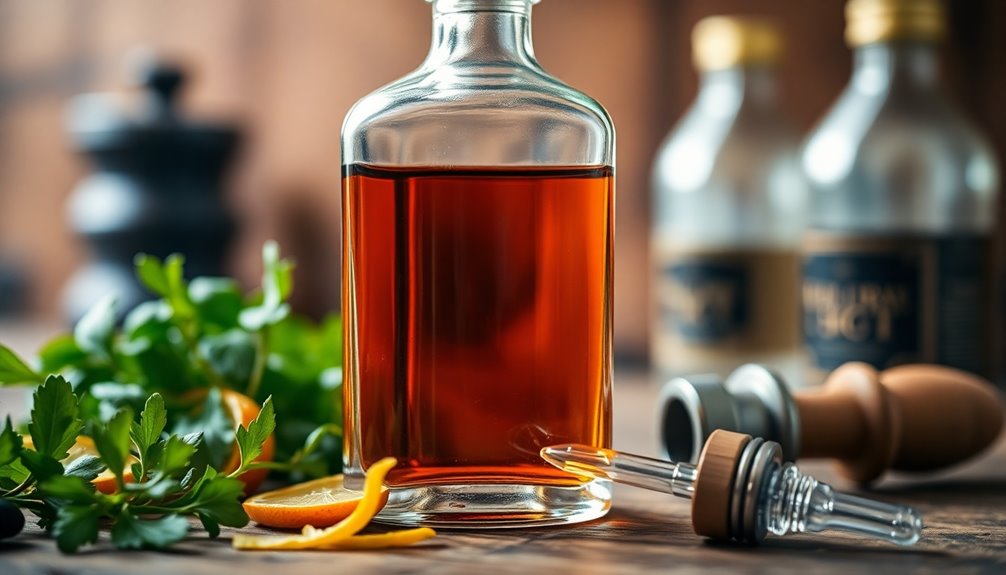
Aromatic bitters are high-proof infusions crafted from a blend of botanicals and spices that enhance the flavor profiles of your cocktails. These complex concoctions typically include flavors like cinnamon, nutmeg, and clove, making them essential in classic cocktails such as the Old Fashioned and Manhattan.
Originally created in the early 1800s for medicinal purposes, aromatic bitters have evolved into a crucial component of modern mixology. When you add 4-6 dashes of these bitters, you markedly transform the taste and balance of both alcoholic and non-alcoholic beverages.
Think of aromatic bitters as your cocktail spice rack, providing depth and complexity, while also elevating mixers like tonic water and ginger beer. They're a game changer for any drink enthusiast!
Key Ingredients and Their Benefits
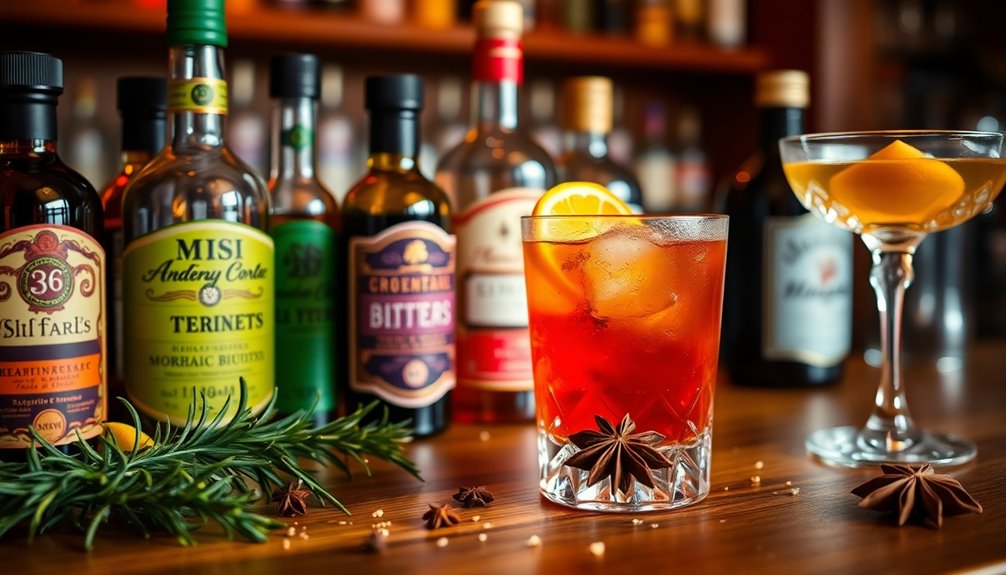
Crafting the perfect cocktail relies heavily on the key ingredients that make up aromatic bitters. These elements create a rich flavor profile and a bitter backbone, balancing the sweet and sour components of your drink. Traditional ingredients like gentian and wild cherry bark provide bitterness, while non-traditional additions such as grains of paradise and cinnamon introduce complexity and unique flavors. Many aromatic bitters also include health-supportive ingredients like milk thistle seed, promoting digestion and liver health.
| Key Ingredient | Flavor Contribution | Health Benefits |
|---|---|---|
| Dried Bing Cherries | Sweet, fruity | Antioxidant properties |
| Fresh Ginger | Spicy, warming | Supports digestion |
| Gentian | Bitter | Aids in appetite stimulation |
| Grains of Paradise | Peppery, citrusy | Anti-inflammatory properties |
| Milk Thistle Seed | Earthy | Liver detoxification |
Historical Significance of Bitters
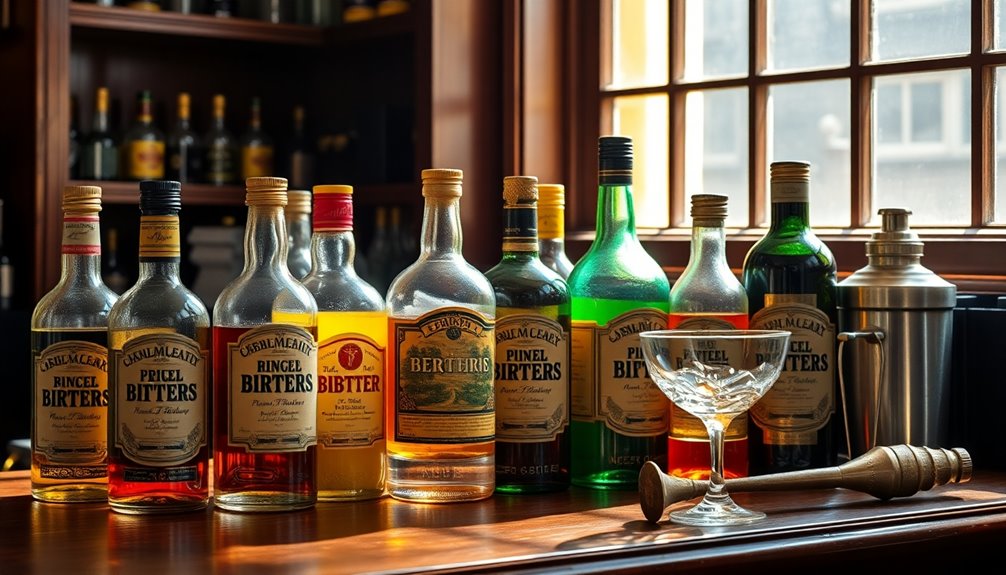
Bitters have a fascinating history that starts with their medicinal roots in the early 1800s, where they were used to treat various ailments.
As cocktail culture blossomed in the 19th century, bitters shifted into essential mixology ingredients, enhancing flavor balance.
Understanding this evolution can deepen your appreciation for the role bitters play in modern cocktails.
Medicinal Origins of Bitters
Though often associated with cocktails today, the roots of bitters trace back to the early 1800s when they were created primarily for medicinal purposes.
Originally, these bitters were prescribed to treat ailments like malaria and digestive issues. The first commercial bitters, Angostura, was developed in 1824 by Dr. Johann Siegert, a German physician aiming to create a tonic for soldiers.
Early formulations featured a blend of herbs and spices, including gentian root, renowned for its digestive properties. While bitters evolved into cocktail culture, many still recognize their potential health benefits. Visualization techniques for improving health and wellness, much like those used in the Law of Attraction, can also apply to the use of bitters today.
Today, you'll find modern bitters crafted with organic botanicals, keeping the spirit of their medicinal origins alive while enhancing your favorite drinks.
Evolution in Mixology
As cocktail culture blossomed in the mid-19th century, aromatic bitters carved out an essential role in mixology, transforming from medicinal remedies into important ingredients for bartenders.
The first successful bitters, Angostura, emerged in 1824, initially serving as a tonic. By the time you enjoy a classic Old Fashioned, you're experiencing the bitters' evolution in mixology firsthand.
They're perfect for enhancing flavors, adding depth and complexity to cocktails like the Manhattan.
As the craft cocktail movement surged in the late 2000s, bitters regained popularity, inspiring a wave of artisanal creations.
This revival celebrates the rich history of bitters, proving they're not just a garnish but a critical element in your favorite drinks, elevating your cocktail experience.
Applications in Classic Cocktails
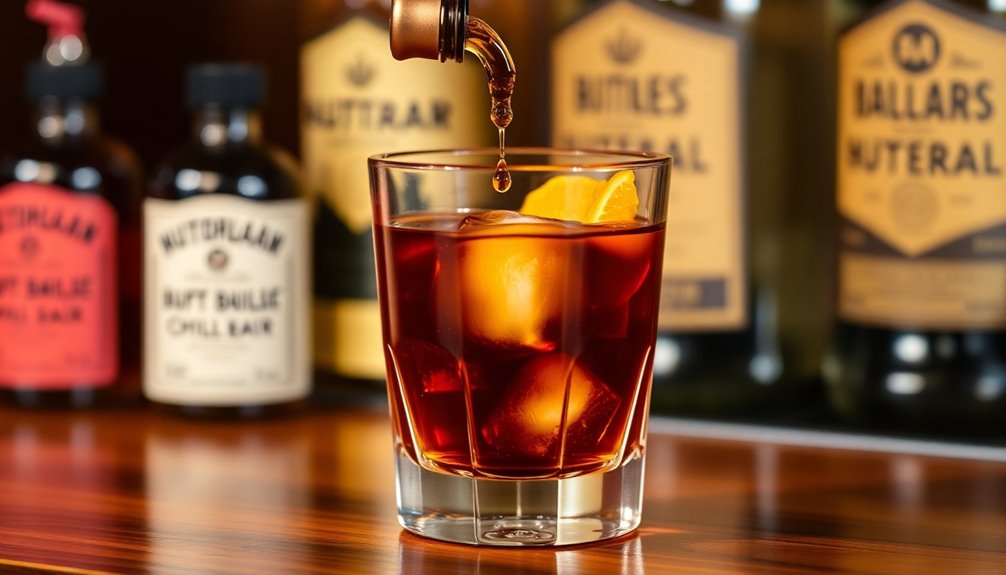
When crafting classic cocktails, aromatic bitters play an essential role in elevating flavors and adding complexity. In an Old Fashioned, just 4-6 dashes enhance the drink's depth with notes of baking spices and cherries.
Similarly, in a Manhattan, bitters provide a bitter backbone that balances the sweetness of vermouth and the richness of whiskey, creating a harmonious sip.
You can also experiment with a Sazerac, where aromatic bitters complement rye whiskey and sugar, enriching the overall experience.
Even in an Americano, they add warmth and spice to the invigorating blend of vermouth and soda water.
And if you're feeling adventurous, a few dashes in sparkling water turn it into a sophisticated bitters and soda.
Versatility Beyond Cocktails
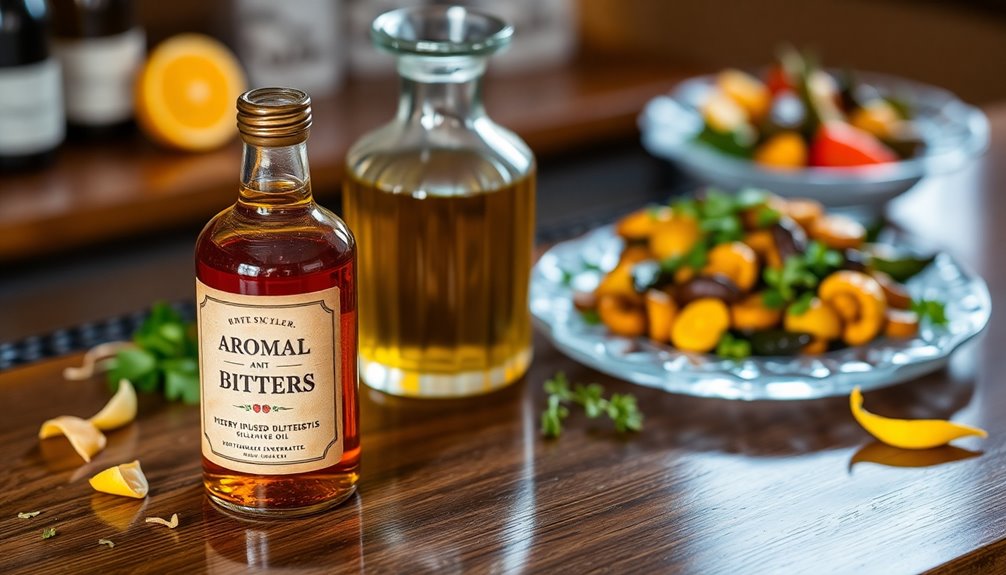
Aromatic bitters aren't just for cocktails; they can transform a variety of beverages and dishes into something extraordinary. Their versatility shines through in many ways:
- Add them to sparkling water for a revitalizing non-alcoholic drink, known as bitters and soda.
- Enhance mixers like tonic and ginger beer, boosting complexity in simple beverages.
- Incorporate them into culinary applications like salad dressings and marinades to elevate flavors.
- Drizzle them over fruit or use them in desserts such as chocolate mousse and fruit compotes for added depth and balanced sweetness.
With aromatic bitters, you'll discover new dimensions in your favorite drinks and dishes, making every sip and bite a delightful experience.
Storage and Shelf Life

Aromatic bitters have an infinite shelf life, making them a great investment for your home bar.
To keep their quality and flavor intact, store them in a cool, dark place.
While their taste may evolve over time, rest assured they won't spoil and will continue to enhance your favorite drinks.
Infinite Shelf Life
Although some ingredients in your bar may have a limited lifespan, aromatic bitters stand out with their infinite shelf life, ensuring they can enhance your cocktails for years to come.
These versatile cocktail ingredients don't spoil, making them a cost-effective addition to your home bar. While the taste might evolve, their effectiveness remains intact.
Here are some key benefits of aromatic bitters:
- No refrigeration needed: Easy to store in your home bar.
- Long-lasting: Enjoy them for years without worry.
- Versatile use: Perfect for cocktails and other beverages.
- Cost-effective: A little goes a long way, making them a smart purchase.
Keep a bottle handy and elevate your mixology game!
Storage Recommendations
To guarantee your bitters maintain their exceptional flavor and quality over time, store them in a cool, dark place away from direct sunlight and heat.
Once opened, aromatic bitters can last for years without significant degradation in taste, thanks to their high alcohol content.
Proper storage in tightly sealed bottles not only prevents contamination but also helps retain the essential properties that make bitters unique.
While the flavor may evolve over time, this doesn't impact their usability or safety.
So, whether you're using them in cocktails or culinary dishes, following these storage recommendations guarantees your aromatic bitters stay fresh and effective for all your mixing needs.
Enjoy the longevity of your bitters with just a little care!
Flavor Evolution Over Time
Storing your bitters correctly not only preserves their quality but also allows their flavors to evolve over time. Aromatic bitters have an infinite shelf life, and as they age, they can develop unique flavor profiles that enhance your cocktails in unexpected ways.
Here are some tips to guarantee you enjoy the full versatility of your bitters:
- Store in a cool, dark place
- Keep the cap tightly sealed
- Avoid exposure to light and heat
- Experiment with aged bitters in various cocktails
Even as flavors change, aromatic bitters will still balance sweet and sour elements, maintaining their essential characteristics.
This longevity gives you endless opportunities to experiment and elevate your cocktail crafting. Enjoy the journey of flavor evolution!
Choosing the Right Bitters
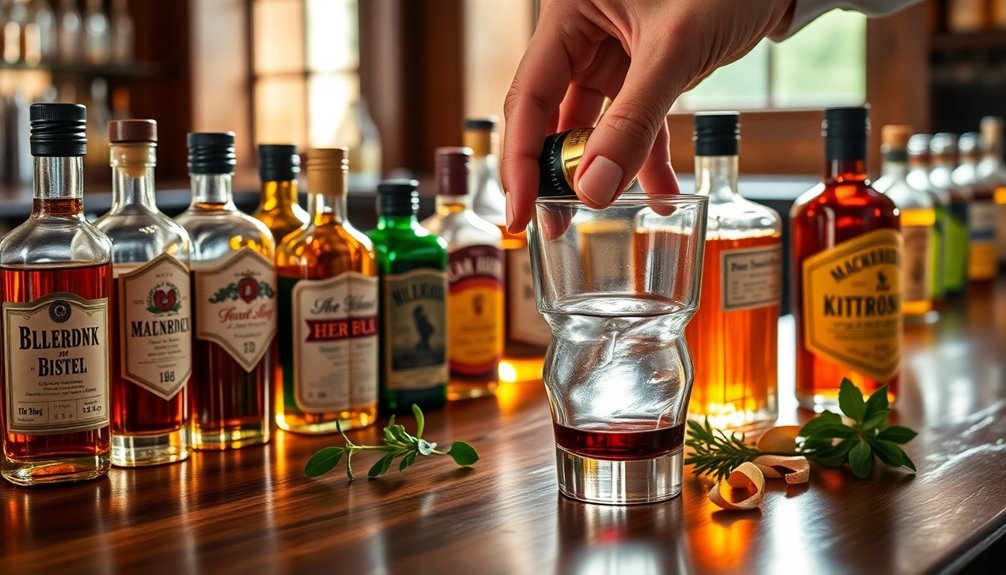
How do you choose the right bitters for your cocktails? First, consider the flavor profile you want to achieve.
If you're making a classic Old Fashioned or Manhattan, aromatic bitters are your best bet, offering warm, earthy notes that enhance darker spirits. For lighter drinks like gin martinis or margaritas, try orange bitters for a rejuvenating citrus twist.
Understanding the differences between bitters types is essential; aromatic bitters add depth, while orange bitters bring brightness. Don't hesitate to experiment with both to release your creativity and discover unique flavor combinations.
Ultimately, personal preference plays an important role, so taste different brands and styles until you find the bitters that resonate best with your palate and elevate your cocktail experience.
Frequently Asked Questions
What Do You Do With Aromatic Bitters?
You can use aromatic bitters in a variety of ways to elevate your drinks and dishes. Just add a few dashes to cocktails like an Old Fashioned or Manhattan for a complex flavor.
You can also mix them into soda or tonic for a revitalizing beverage.
Don't stop there—try incorporating them into salad dressings or desserts to introduce a unique twist.
With bitters, your culinary creativity knows no bounds!
What Is the Purpose of Drinking Bitters?
Ever wondered why people sip bitters?
You might find it intriguing that drinking bitters can be more than just a quirky trend. Many believe these concoctions aid digestion and provide relief from stomach discomfort.
When you take a sip, you're not just enjoying a unique flavor; you're also tapping into a tradition that blends taste with potential health benefits.
Can You Drink Straight Aromatic Bitters?
You can technically drink straight aromatic bitters, but it's not a common practice.
Their intense flavor and high alcohol content make them hard to enjoy on their own. Instead, most people use a few dashes in cocktails to enhance the taste.
While some may consume small amounts for perceived health benefits, it's generally best to mix bitters into drinks like an Old Fashioned or Manhattan to appreciate their complexity.
When Should Bitters Be Avoided?
Bitters can be like a double-edged sword; they enhance cocktails but can cause trouble if misused. You should avoid bitters if you're allergic to any of the ingredients or have liver disease—consult your doctor first.
If you're crafting drinks for kids or non-drinkers, skip the bitters entirely. Also, don't overdo it; more than 4-6 dashes can ruin your drink's balance and flavor.
Stay mindful of your health and preferences!
Conclusion
Aromatic bitters are more than just a cocktail ingredient; they've been a staple in mixology since the 19th century, with over 30 varieties available today. These potent flavor enhancers can elevate your drinks and even your culinary creations. With just a few dashes, you can transform a simple beverage into a complex experience. So next time you're mixing up a drink, remember that a little goes a long way in bringing depth and character to your creations!










